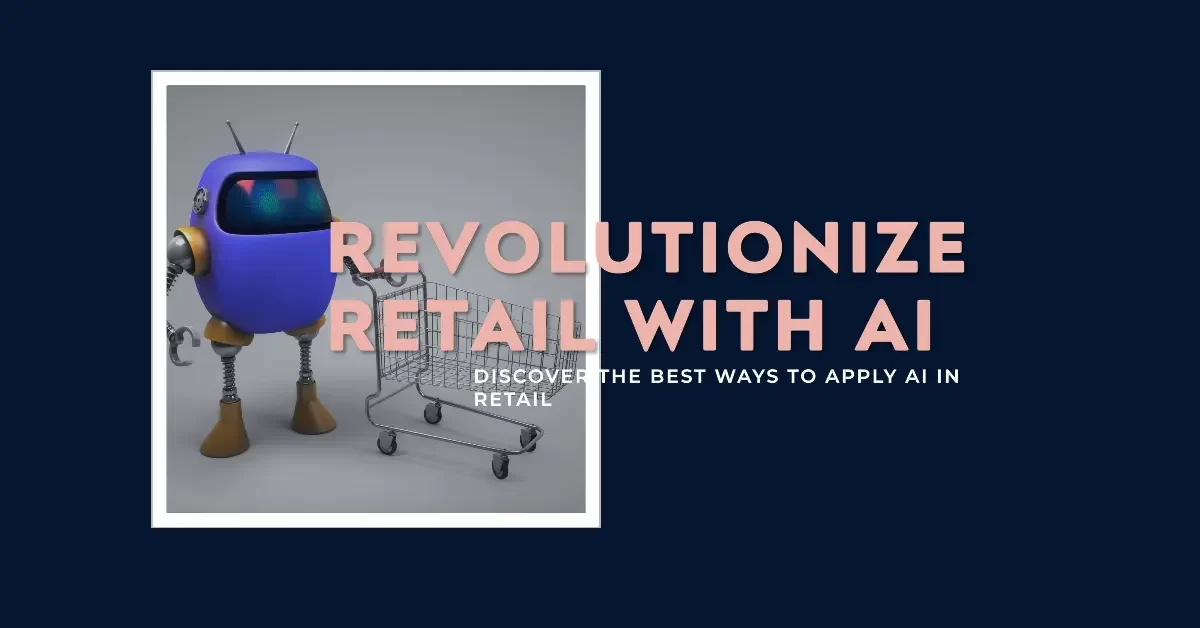Many of the strategies adopted have been really effective and have promoted strong movements in what we could call the post-pandemic. An example of this is the use of Artificial Intelligence in retail commerce. This resource was already being used, mainly by large electronic businesses, in various situations.
However, it is now becoming popular with other forms of application.
What are the current trends of the use of artificial intelligence in retail?
Although it is not new, the implementation of Artificial Intelligence in retail continues to progress. The process of adopting this custom software development services varies depending on the business model, the available budget and the size of the venture.
Thus, larger companies, such as large chain stores and e-commerce with a high volume of transactions, were adopting this resource or quickly investing in it in the context of the COVID-19 pandemic. Meanwhile, although to a lesser extent, mid-sized retailers are still resisting this transformation and are beginning the change slowly, driven more by necessity than conviction.
However, customers already live with Artificial Intelligence in retail commerce on a daily basis. Chatbots, virtual fitting rooms, offer personalization algorithms, self-service systems, and omnichannel platforms are some examples. After all, Artificial Intelligence is found in applications from the production and sale of products to after-sales.
In this sense, AI has contributed to the growth and development of retail commerce, since it allows the analysis of large volumes of data that the virtual environment provides practically in real time, the interpretation of immense quantities of events in the light of commercial intelligence and obtaining responses to the new demands of a constantly changing market, thus guaranteeing a competitive advantage.
What are the main applications of artificial intelligence in retail?
Not only are strategies and applications that use AI evolving, but new ways to apply Artificial Intelligence in retail are also frequently emerging. Here are 7 of the main uses of this technology that commerce simply cannot ignore:
STORAGE AND INTERPRETATION OF PRODUCT HISTORY
They are strategies that, by evaluating the performance of the products before the consumer public, allow appropriate actions to promote the increase in the average ticket , automatically making suggestions for complementary products to the one purchased, for options that other people who bought the same items also purchased and for products classified as similar. Evaluating product performance with contextual analysis allows us to perceive contexts in which a product performs better or worse, combining external factors such as weather, news, influencers and competitive prices with local contexts such as the location of the products in the area. of the physical store, provision of information in online channels and an infinite number of aspects whose combination and interpretation would be impossible to obtain in the traditional analysis model.
Artificial Intelligence has been used for this for some time, storing and analyzing customer history to offer, with increasing precision, good advice to the consumer.
AI IN INVENTORY MANAGEMENT
It was never good business to work with large volumes of stored goods, however, the more intelligence retail uses , the more vital good inventory management becomes.
On the other hand, the lack of products on the shelves, which causes the so-called breakdown, is perhaps one of the worst fears for the retailer. It is having a customer who wants to buy and not being able to provide them with the product.
In this way, inventory management must be precise, considering seasonalities, regionalities, economic and social aspects, trends and information in general.
Artificial intelligence used appropriately can analyze these countless factors in large volumes, allowing balance to be maintained, meeting demands without surpluses that generate financial losses.
OPTIMIZING THE PURCHASE PROCESS
These software development services can statistically predict what the output rate of a product will be and estimate the ideal quantity to purchase. In the same way, it effectively supports the purchasing area professional in carrying out the process in the most advantageous way.
To do this, AI considers internal data, such as sales, delinquencies, customer profiles, and external information, such as trends in social networks, GDP forecasts, consumer confidence index, purchasing power, in a broad analysis whose execution would be unfeasible for a human being.
RFID TECHNOLOGY
RFID is Radio Frequency Identification . This is a technology that uses a label affixed to goods whose information can be detected by readers. These readers can be portable handheld devices or even portals that identify products in large quantities moving through a warehouse or store.
This mechanism generates location inputs for products or even people, if a label is placed on an identification card, for example.
The association between these generated information inputs and Artificial Intelligence applications allows not only to detect irregularities in the movement of what is being monitored, but also to have a perception of actions to take in real time to guarantee that logistics processes are permanently agile and safe. .
Given that logistics is known today to be one of the main competitive differentials of retail companies, the use of this type of strategy effectively contributes to the retailer’s results and customer satisfaction.
CUSTOMER BEHAVIOR
Almost all business decisions are made based on customer preferences. Given this, knowing your behavior and consumption patterns makes these decisions easier. Artificial Intelligence provides information based on large volumes of data from various sources so that commerce can fully serve the consumer.
What was previously represented with a heat map, which simply indicated the places in the store where there was a large flow of customers, with artificial intelligence allows the perception of effective results from customer behavior.
TRANSFORMATION IN THE CUSTOMER JOURNEY
It is a very old concept. The first retailers were already observing the steps of their customers and were already making efforts to make these steps (journey) a more pleasant process, and in this way, if observed well, they could lead to better sales. As technology evolved, the methods of defining and perceiving trips and micro-trips were being perfected, and the mathematical models were becoming more effective, techniques and actions to attract, educate and sell based on the behavior of the public were gaining more. and more relevance.
Although there is a tendency to think about travel always looking at the online channel , travel is today associated with an omnichannel approach , in which the interaction with physical channels is as important as the interaction of customers with the brand through online channels.
Really knowing and understanding the customer journey and its specificities is an invaluable achievement since, by really knowing your customer and their journey well, you can successfully transform the customer’s interaction with the brand. Data on the period in which you are active, the factors that influence your consumption decision, etc., are essential in this context.
AI, as a tool for working with a large volume of information, allows you to successfully transform this process, allowing:
- The customer journey is detected and permanently improved.
- Interaction with the brand will never be a concern or displeasure for the customer.
- Travel is equally pleasant, regardless of the channel used.
- All customer journeys are permanently tracked and improved, regardless of the volumes involved.
- The service can be automated when possible, without it being a moment of stress for the customer, in a way that is compatible with their journey.
- In an omnichannel vision, any irregularity is detected and dealt with immediately.
PERSONALIZED ATTENTION TO CUSTOMER
The focus on personalized attention to customers has existed since before CRM solutions began to emerge on a large scale in the market.
Many decades ago, before large networks were so numerous, treating the customer not as a number, but as someone known to the store always gave good results.
As stores grew and became networks, impersonality became a detrimental factor of distancing between the customer and the brand.
If even the basic information in the interaction with the customer was not maintained and used properly , what about their tastes, preferences and peculiarities?
Several tools have emerged with the aim of solving this difficulty, and a long way has been made until the customer has the perception that brands practice a personalized relationship in a genuine and not superficial way.
For some time now, customer empowerment, the increase in the use of social networks and the multiplication of purchasing options available to consumers have required that not only the customer be treated in a personalized way in their basic characteristics, but also their tastes. and preferences are detected, followed and respected permanently.
In order for this level of personalization , which by the way is the only one truly perceived by the client, to be practiced, the use of artificial intelligence resources is essential.
Empowering luxury retailers to create personalized experiences with AI
● Expanding the vision of Artificial Intelligence in Retail
Expanding a little on the aspects discussed in the previous seven topics, it is worth illustrating more broadly the points in which artificial intelligence really adds value to retail:
- The need to use technologies to sustain themselves has led many retailers to realize the benefits of Artificial Intelligence for their operations and strategies, such as:
- Operational or logistical optimization, making the execution of tasks effective and reducing their costs.
- Precisely direct marketing and sales actions, increasing their efficiency and conversion rate.
- Eliminate the direct action of the team in repetitive, bureaucratic, slow activities that contribute little to the results, increasing their productivity.
- Greater ability to forecast demands to make exact purchases or provide a personalized experience to the consumer, increasing their satisfaction and loyalty.
- More depth for data analysis and scalability in process automation.
- Implementation of means for continuous improvement, innovation and differentiation.
- Anticipation of patterns and identification of trends to take advantage of opportunities and prevent crises.
Consequences of not investing in the implementation of Artificial Intelligence
However, the acceleration of digitalization indicates that those who do not invest in its implementation will fall behind their competitors and risk losing space in the market.
Additionally, it is important to note that competitiveness in retail is closely linked to the ability to optimize your operations, foresee trends and, above all, satisfy the customer with a personalized experience . These aspects are possible and enhanced by AI.
If you also want your company to enter the digital era, the way to achieve this is to take advantage of the 7 applications for Artificial Intelligence developed by trusted custom software development company in retail that we mention in this article. You just need to see the benefits of investing in this resource and the consequences of not doing so to know what is the right decision to make.

